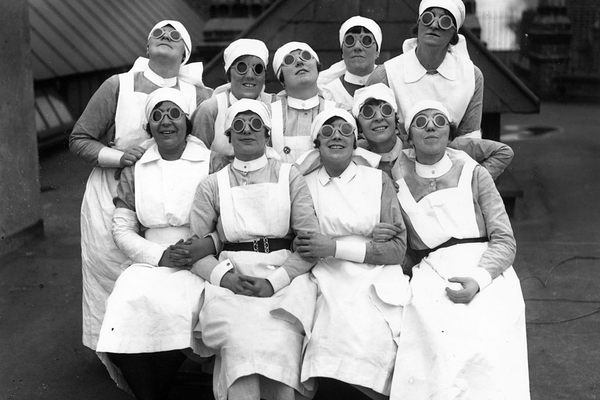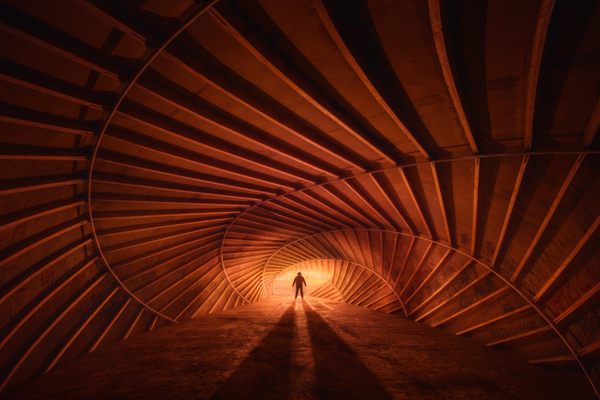Meet the Snake-Hatted Woman and Elastic Skin Man of the Harvard Theatre Collection
One of the largest performing arts collections in the world also has some of the most unusual visuals.
German broadside depicting the varied performances of the ‘Fire-King’ Paul Schwarzenberg and the contortionist C. Coppal, 1839. (All photos: Courtesy of Houghton Library, Harvard University)
If you’re looking for materials related to performance, the Harvard Theatre Collection will have something for you. Even if what you’re looking for is a photo of a man stretching his facial skin as though it were made of spandex.
Founded in 1901, and part of Harvard’s rare books and manuscripts collection in the Houghton Library, it’s one of the largest performing arts collections in the world.
Fortunately, you don’t necessarily have to visit to experience this unique collection. In March of this year, curator Matthew Wittmann began posting a variety of performance-related ephemera on the Harvard Theatre Collection’s Instagram account, from the obscure to the well-known.
Says Wittmann: “I came to Houghton Library with a background in the history of the American circus so I am partial to popular entertainment, which not coincidentally seems to produce a lot of eye-catching material. Still, we have a very broad collection so I try to show that with images of ballet dancers, set designs, photography, etc.”
Wittmann, who joined the collection earlier in 2016, found it took some time to get a handle on all there is to offer. “Probably the most fascinating discovery has been the Burns M. Kattenburg Collection, which documents the careers of hundreds of contortionists from around the world. It has a little bit of everything—letters, ephemera, photographs—and some of the subjects performed truly incredible feats so it is great just to browse through.”

A signed photo of Ben Dova in a “hair pin” pose from the Burns M. Kattenburg Collection.
Among the other highlights in the Harvard Theatre Collection are over 400 annotated Shakespeare scripts dating back to 1756. Actors, directors and managers all made their marks, quite literally, on the yellowed pages that now reside in the archives. Then there’s the Angus McBean Archive, a vast collection of photographs of British theater stars and productions from the 1930s through to the 1960s. When Harvard acquired the collection in 1970, the 30,000 images and glass negatives were transported from the UK by ship.
While the collection is searchable online, Instagram can help in getting the material seen by a broader audience. “I think that Instagram has proved to be a great way for librarians and museums to give the public a look at their collections,” says Wittmann. “Ideally, a viewer will learn something new with every post.”
Atlas Obscura was so intrigued by the Collection that we asked Wittmann to delve into the archives; the results are this quirky and unusual collection of images. With Instagram, Wittmann ultimately wants “people to come away with is an appreciation for the breadth and depth of our collections. And of course, I hope this window into our world will lead students and researchers to visit and use the collection for their own projects and work.”
You can follow the Harvard Theatre Collections on Instagram at @harvardtheatre.

A stunning portrait of the serpentine-hatted snake-charmer “Girleto.”

Chromolithograph poster depicting the one-legged trick rider Charles G. Kilpatrick performing his signature feat, ca. 1900.

Cabinet card of Leon, an iron-jaw performer, which shows off his impressive strength.

Engraving depicting a performance by E. D. Davies, an Irish ventriloquist who used figures named Tommy and Joey, ca. 1860s.

Cabinet card of Maurice, the “Tasmanian Elastic Skin Man.”

Cabinet card featuring one of the feats performed by Mazie Hanson, the “iron-chested Amazon.”

Hand-colored etching of assorted equestrian tricks performed by the Franconis, one of the great European circus families, ca. 1800.

Woodcut engraving advertising a performance at the “Monkey Theater” in Munich, 1840.











Follow us on Twitter to get the latest on the world's hidden wonders.
Like us on Facebook to get the latest on the world's hidden wonders.
Follow us on Twitter Like us on Facebook